- Table of Content
- 1.Space Weather ...
- 2.Innovation day...
- 3.Review of sola...
- 4.Review of geom...
- 5.PROBA2 Observa...
- 6.The Internatio...
- 7.Noticeable Sol...
- 8.Geomagnetic Ob...
- 9.The SIDC space...
- 10.Action!
2. Innovation day PITHIA-NRF June 21, Rome
3. Review of solar activity
4. Review of geomagnetic activity
5. PROBA2 Observations (6 Jun 2022 - 12 Jun 2022)
6. The International Sunspot Number by SILSO
7. Noticeable Solar Events (6 Jun 2022 - 12 Jun 2022)
8. Geomagnetic Observations in Belgium (6 Jun 2022 - 12 Jun 2022)
9. The SIDC space Weather Briefing
10. Action!
Space Weather Introductory Course
The June 2022 Space Weather Introductory Course (SWIC) delivered 8 Space Weather experts.
program: https://events.spacepole.be/event/136/
More SWICs: https://events.spacepole.be/category/4/
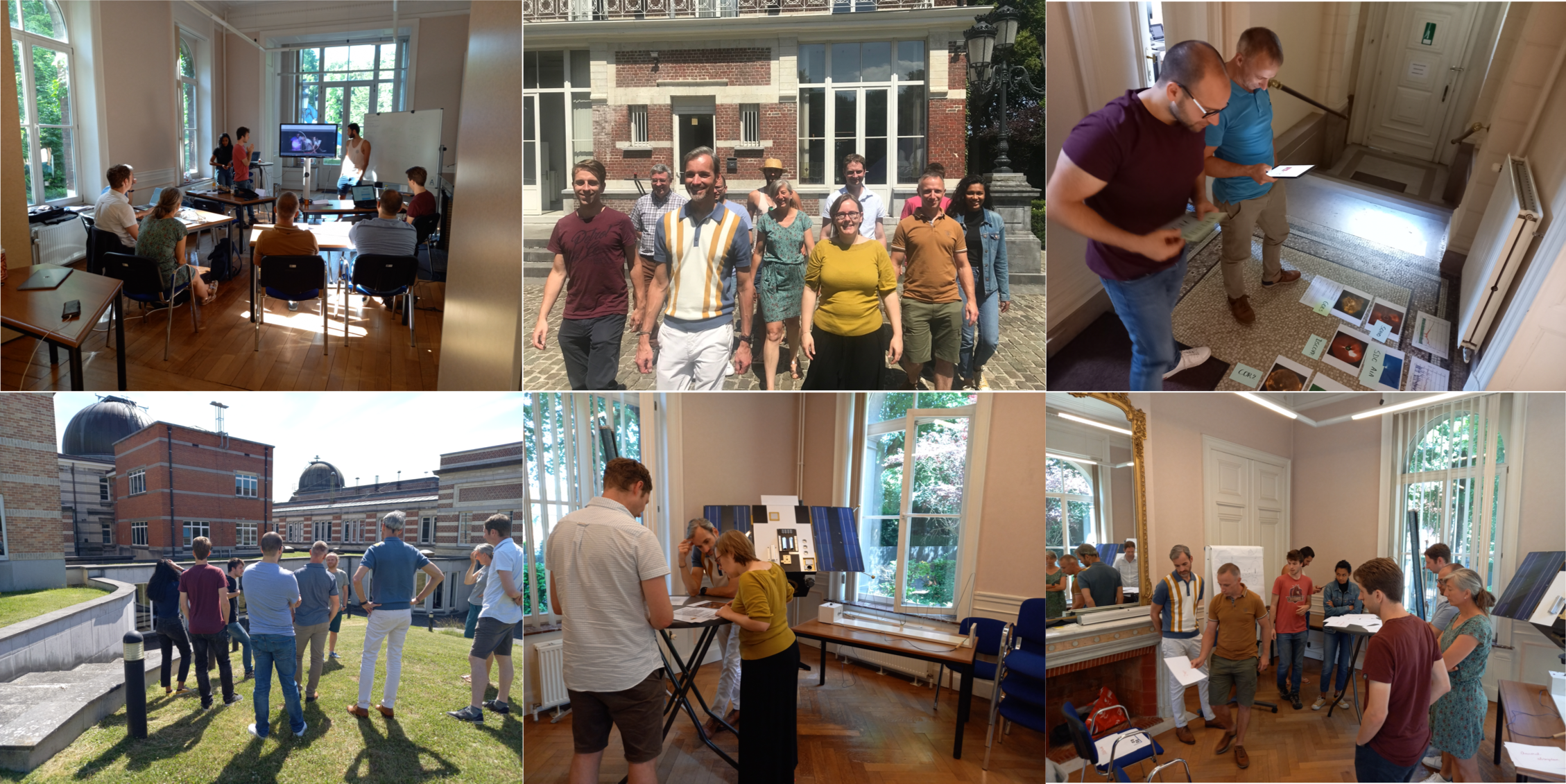
Innovation day PITHIA-NRF June 21, Rome
The innovation day of PITHIA-NRF is on June 21, in Rome.
Check out: https://progetti.ingv.it/en/PITHIA
PITHIA-NRF stands for Plasmasphere Ionosphere Thermosphere Integrated Research Environment and Access service.
It is a Network of Research Facilities) paving the way to new business practices and technological development in the near-Earth and upper atmosphere domains through science. PITHIA-NRF wishes to mitigate the adverse effects of upper atmosphere phenomena that pose scientific, operational, and societal challenges.
Welcome!
On behalf of
Dr. Anna Belehaki, Project Coordinator
Prof. Hanna Rothkaehl, Leader of the Innovation Package
Review of solar activity
The week started with very low solar activity as many of the active regions on disc rotated off the disc, while remaining regions decayed into plage. X-ray flux did not reach above C level until June 9. On June 9 a re-emergence in NOAA active region 3029 caused some minor C flares which were then followed with flaring from the East limb where NOAA region 3030 started to rotate onto the disc. Initially it produced only some C flares but this was soon followed by an M1.2 flare. Only low C flares occurred in remainder of the week, all from NOAA active region 3030.
A number of filament eruptions were observed, but none resulting in Earth directed CMEs.
At the start of the week the greater than 2 MeV electron flux dropped below the 1000 pfu alert threshold and the 24h electron fluence decreased to moderate and subsequently to normal levels.
Review of geomagnetic activity
Slow solar wind conditions were observed for the majority of the week. These were perturbed by the later than expected arrival of the CME that was launched on June 2. On June 6, 9:20UT an associated weak shock arrived with solar wind speed increasing from just below to just over 300 km/s. The magnetic field magnitude reached 14nT as the ICME passed. The north-south component peaked at a negative value of -12nT. On June 12 a somewhat unexpected high speed stream announced itself, with initially speed increasing to just 450 km/s but also magnetic field building up to around 15nT.
Geomagnetic conditions were quiet to unsettled (NOAA Kp 0-3) with only an isolated local active period as K Belgium reached 4 during the CME arrival.
PROBA2 Observations (6 Jun 2022 - 12 Jun 2022)
Solar Activity
Solar flare activity fluctuated from very low to moderate during the week.
In order to view the activity of this week in more detail, we suggest to go to the following website from which all the daily (normal and difference) movies can be accessed: https://proba2.oma.be/ssa
This page also lists the recorded flaring events.
A weekly overview movie can be found here (SWAP week 367). https://proba2.oma.be/swap/data/mpg/movies/weekly_movies/weekly_movie_2022_06_06.mp4
Details about some of this week's events can be found further below.
If any of the linked movies are unavailable they can be found in the P2SC movie repository here https://proba2.oma.be/swap/data/mpg/movies/
Friday Jun 10
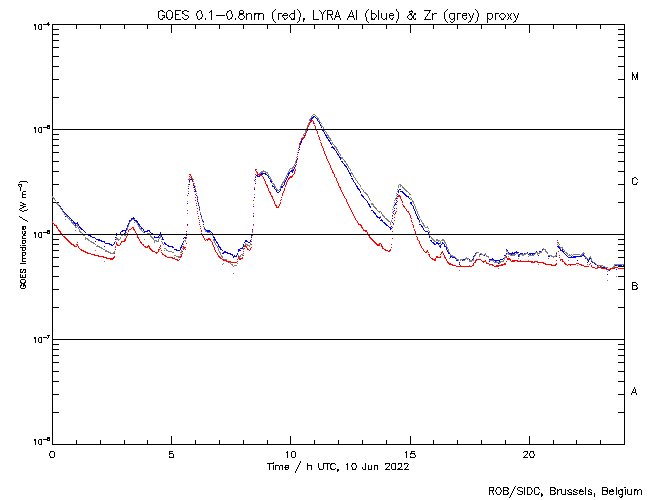
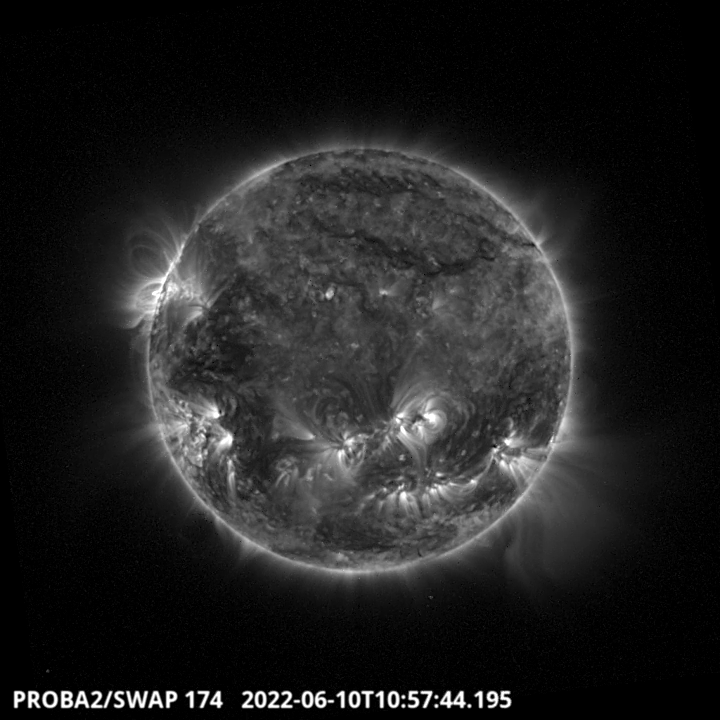
The largest flare of the week, a long duration M1.2, is visible on the LYRA and SWAP images above. It has emerged over the Sun's northeastern limb that morning around 10:57 UT from a new active region (NOAA 3030). Find a movie of the events here (SWAP movie) https://proba2.oma.be/swap/data/mpg/movies/20220610_swap_movie.mp4
The International Sunspot Number by SILSO
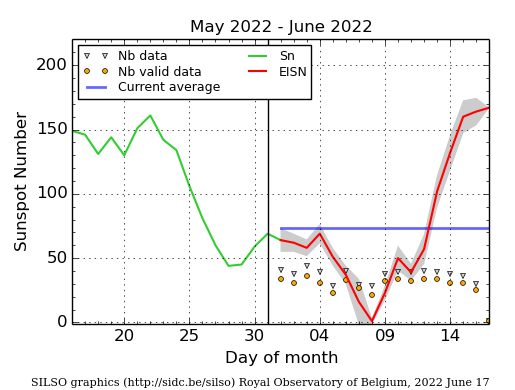
The daily Estimated International Sunspot Number (EISN, red curve with shaded error) derived by a simplified method from real-time data from the worldwide SILSO network. It extends the official Sunspot Number from the full processing of the preceding month (green line), a few days more than one solar rotation. The horizontal blue line shows the current monthly average. The yellow dots give the number of stations that provided valid data. Valid data are used to calculate the EISN. The triangle gives the number of stations providing data. When a triangle and a yellow dot coincide, it means that all the data is used to calculate the EISN of that day.
Noticeable Solar Events (6 Jun 2022 - 12 Jun 2022)
| DAY | BEGIN | MAX | END | LOC | XRAY | OP | 10CM | TYPE | Cat | NOAA |
| 10 | 1011 | 1054 | 1114 | M1.2 | F | 3030 |
| LOC: approximate heliographic location | TYPE: radio burst type |
| XRAY: X-ray flare class | Cat: Catania sunspot group number |
| OP: optical flare class | NOAA: NOAA active region number |
| 10CM: peak 10 cm radio flux |
Geomagnetic Observations in Belgium (6 Jun 2022 - 12 Jun 2022)
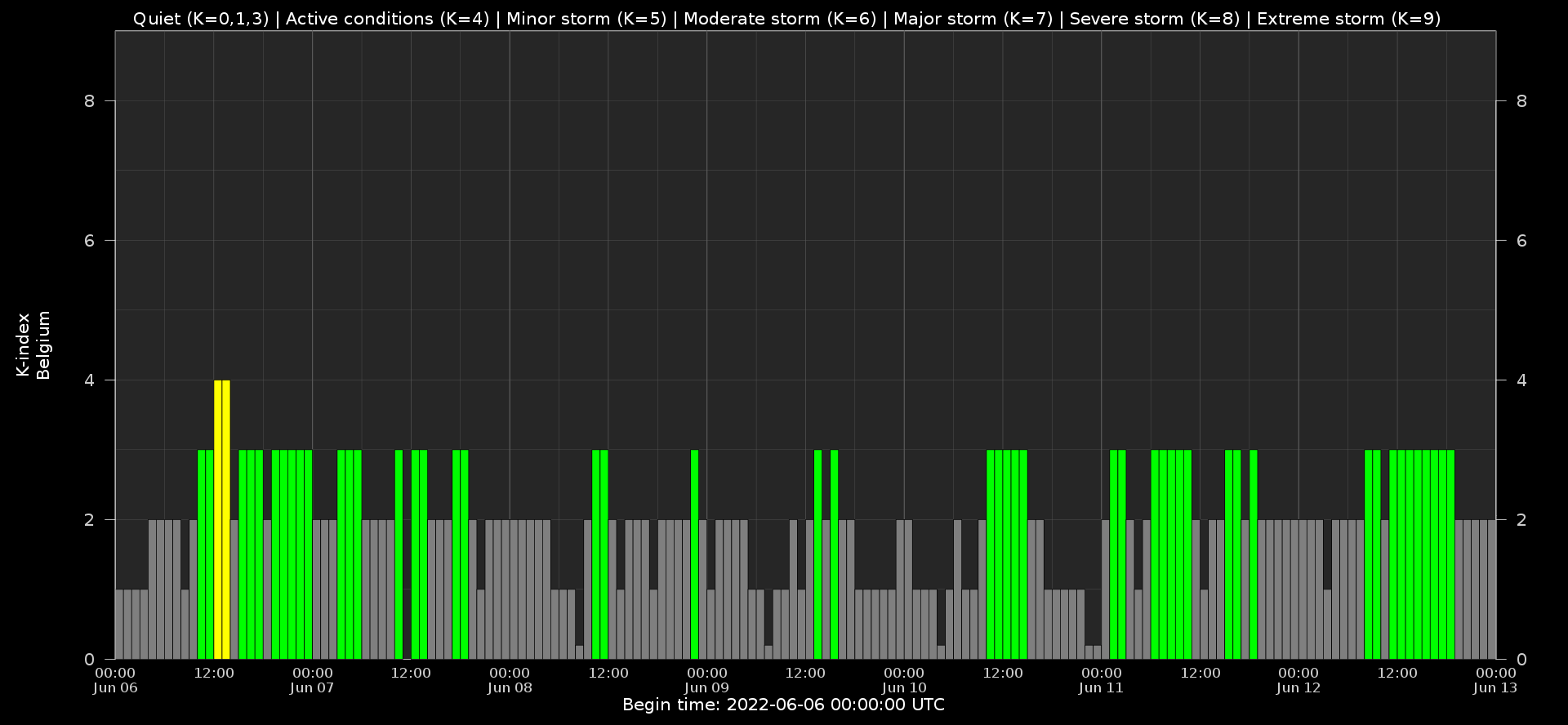
Local K-type magnetic activity index for Belgium based on data from Dourbes (DOU) and Manhay (MAB). Comparing the data from both measurement stations allows to reliably remove outliers from the magnetic data. At the same time the operational service availability is improved: whenever data from one observatory is not available, the single-station index obtained from the other can be used as a fallback system.
Both the two-station index and the single station indices are available here: http://ionosphere.meteo.be/geomagnetism/K_BEL/
The SIDC space Weather Briefing
The Space Weather Briefing presented by the forecaster on duty from June 5 to 12. It reflects in images and graphs what is written in the Solar and Geomagnetic Activity report: https://www.stce.be/briefings/20220613/20220613_SWbriefing.pdf
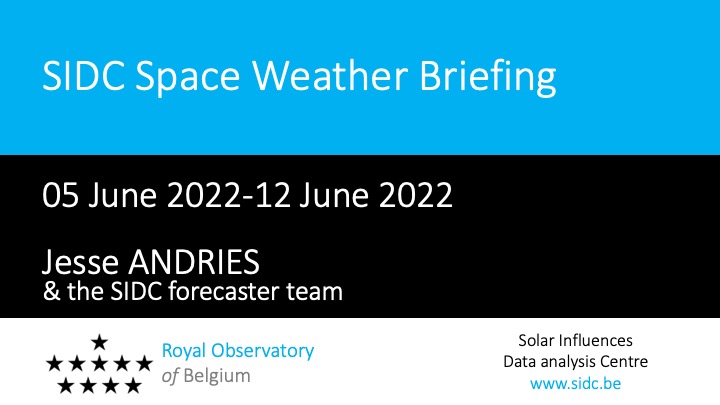
Action!
Check out our activity calendar: activities and encounters with the Sun-Space-Earth system and Space Weather as the main theme. We provide occasions to get submerged in our world through educational, informative and instructive activities.
If you want your event in our calendar, contact us: stce_coordination at stce.be
* June 21, First Innovation day of PITHIA-NRF, Rome, Italy
* June 23, KU Leuven CmPA Seminar: COOLFluiD - High-Order Methods for Transitional Hypersonic Flow Modelling, Leuven, Belgium
* June 25, STCE at the Summer Space Festival, Brussels, Belgium
* July 3, Public Lecture on STCE's missions to the Sun, Cosmodrome, Genk, Belgium
* August 25, Public Lecture on Space Weather and Aviation, Astropolis, Oostende, Belgium
* October 24-28, 18th European Space Weather Week, Zagreb, Croatia
* November 21-23, Space Weather Introductory Course - onsite, by the STCE, Brussels, Belgium
* December 5, 6, 8, 9, Space Weather Introductory Course - online, by the STCE, zoom
Check: https://www.stce.be/calendar
